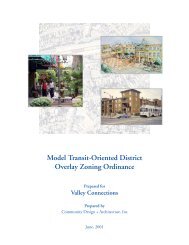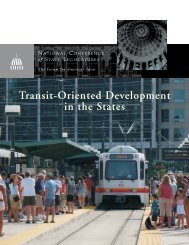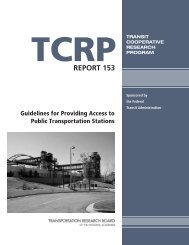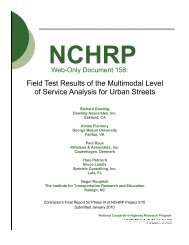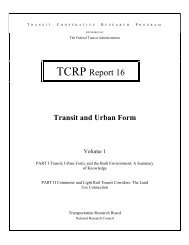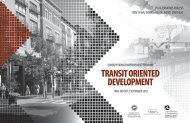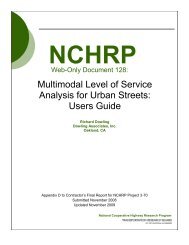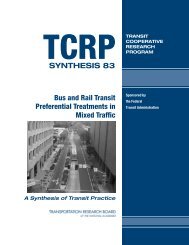Modern Streetcar Vehicle Guideline
Modern Streetcar Vehicle Guideline
Modern Streetcar Vehicle Guideline
Create successful ePaper yourself
Turn your PDF publications into a flip-book with our unique Google optimized e-Paper software.
APTA RT ST- GL-001-13 | <strong>Modern</strong> <strong>Streetcar</strong> <strong>Vehicle</strong> <strong>Guideline</strong>INTRODUCTIONAlthough the vehicle is naturally a major focus of any streetcar operation, in reality it is only one of severalkey sub-systems, all of which must function together as an integrated system. Recognizing that the earlyphases of project design involve key infrastructure decisions that will ultimately impact the vehicle, thisIntroduction provides an overview of vehicle information from the perspective of the planner evaluatingalignment alternatives. The four chapters that follow then look in-depth at the underlying technical andoperating principles that will ultimately drive vehicle selection.<strong>Streetcar</strong> and light rail systems (often defined collectively as “tramways” in Europe) operate in more than 400cities throughout the world, with systems varying considerably in form and function, as well as regulatoryrequirements. While streetcars are often thought of in the urban circulator context here in the U.S., they canalso be deployed in a “rapid streetcar” mode that speeds service by using less frequent stops and trafficseparation / priority, or even as a precursor to a full light rail system. Partial inter-operation with an otherwiseseparate light rail system is also possible.At present in North America, the modern streetcar can also vary a great deal from other modes in terms of theinstitutions involved. Given their potential value as an urban development tool, modern streetcar projects arecurrently being advanced by numerous different types of organizations, including some who do not have agreat deal of experience with transit operations, delivering major capital projects, or which have a corefunction that is very different from a traditional transit authority. These include city governments, businessimprovement districts, non-profits and other non-traditional projects sponsors. Worldwide, project deliverymethods are also changing, potentially impacting how vehicles are sourced. While this further illustrates thediversity and potential flexibility of the mode, it also highlights the importance of ensuring that streetcarsystems live up to their potential in terms of their core transit functionality.Since the advent of modern low-floor vehicle technology in 1984, more than 8,000 low-floor streetcar / lightrail / tramway vehicles have been ordered, (1,400 in North America). Given the wide range of applicationsworldwide, vehicle requirements vary substantially, as do the opinions of different cities about the desired“look” of their vehicles. Carbuilders (of which there are a relatively limited number) have responded bydeveloping modular product lines that permit multiple vehicle configurations and visual design elementsbased around standardized vehicle “platforms.” Within these modular product families, customers can selectfrom a catalog of “standard” options to tailor the vehicles to their system. These standard options typicallyinclude the number of vehicle “modules” (and thus overall length and capacity), the number and location ofdoors, a choice among three standard widths, varying interior appointments, vehicle end styling, and interiorand exterior color schemes. By selecting options from within a standard product range, vehicle costs anddelivery times can be reduced while still providing an individual identity for the vehicles in each city.As a starting point for vehicle selection on a new system, this <strong>Guideline</strong> document explores the importanttechnical and operating issues that will become decision points for local project development. Given theindustry’s use of modular vehicle “platforms”, consideration is also given to identifying the dividing linebetween “standard” and “custom” for different vehicle characteristics. While there are many possiblevariations on the streetcar vehicle concept, the standard products available in the marketplace tend to fallwithin certain basic ranges. Rather than starting from scratch on each project, the selection process shouldfirst look at the basic ranges of vehicle configuration and performance characteristics. That said, it is alsonoted that legacy systems exist throughout the world which, because of the requirement for compatibility withexisting vehicle fleets and infrastructure, routinely purchase vehicles that fall outside these standard ranges.Such systems tend to purchase vehicles in relatively large numbers, absorbing the extra costs associated with© 2013 American Public Transportation Association Page 1 of 75




